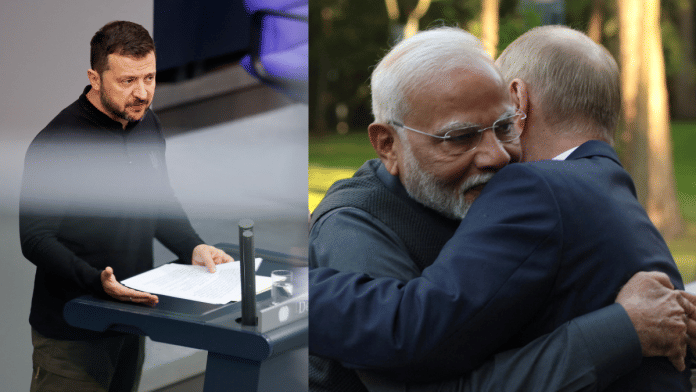The underlying sentiment of the 1966 blockbuster “The Russians Are Coming The Russians Are Coming” is passé. Under Vladimir Putin, Russia has already made its presence felt. President Putin was “delighted to see” his “dear friend”, Prime Minister Narendra Modi, who travelled to Moscow this week on his first bilateral visit of his third term.
The world, including the US, Europe, and China, keenly watched the blooming India-Russia friendship, the warm hug between the two leaders, an EV buggy ride, and the signing of multiple strategic agreements. At the end of the 22nd India-Russia Annual Summit, both countries agreed on several measures to take forward bilateral practical cooperation and further develop their Special and Privileged Strategic Partnership.
India’s emergence as the fulcrum of economic growth in Asia, particularly South Asia, lends greater credibility to the two economies’ agreement to develop new avenues for bilateral payment settlements using national currencies and to introduce digital financial instruments for mutual transactions. This bilateral settlement system will enable both countries to conduct high-value trade in goods and services, including crude oil and nuclear technologies, in their respective currencies. By securing this agreement with Moscow, New Delhi has skilfully decoupled itself from China’s politically motivated but impractical de-dollarisation idea aimed at challenging what Beijing calls dollar hegemony. Even if Moscow wishes to join the BRICS’ proposed de-dollarisation, it would not affect India-Russia bilateral trade nor involve New Delhi in the “war against dollar hegemony”.
PM Modi’s visit has cemented efforts to speed up the Northern Sea Route, the International North-South Transport Corridor (INSTC), and the Chennai-Vladivostok Sea Line. The agreement to “increase cargo turnover with India” through the launch of new routes for the INSTC—a game-changing initiative signed by India, Russia, and Iran in 2000 with 13 members on board—aims to enhance trade and transport connectivity among countries along its route.
India has clearly strengthened its trade potential, technological prowess, and international and regional connectivity while maintaining a safe distance from US/West bashing. Washington and several European capitals have been closely monitoring the Prime Minister’s visit, his meetings with Putin, and analysing their ‘body language’ to pick holes in and castigate New Delhi.
Moscow Summit vs Washington Summit
Coinciding with the Modi-Putin meeting, the US was hosting the heads of state and government of the 32 NATO members, their partner countries, and the European Union (EU). The theme of the summit was “Ukraine and Transatlantic Security,” focusing on NATO’s response to escalating global threats to peace and democracies, particularly the ongoing Russia-Ukraine conflict. While NATO is seriously concerned about North Korea’s support for Russia through weapon supplies and troop deployments to Ukrainian frontlines, NATO members are expected to discuss, and probably applaud, Ukraine-South Korea cooperation for “urgent supply of air defense systems”. Despite NATO’s fulminations against Russia and its disapproval of the Modi-Putin meeting for not addressing Ukraine, the chances of Ukraine’s admission to NATO or the EU are minimal, to say the least.
In these circumstances, expecting India to persuade Putin to agree to a ceasefire and hold peace talks with Ukrainian President Volodymyr Zelenskyy is futile. Nevertheless, India has expressed concern over the destruction of civilian properties and the loss of innocent lives as collateral damage in the conflict. PM Modi categorically stated in his closing speech, “Whether it is war, conflict or a terrorist attack, any person who believes in humanity is pained when there is loss of lives. But even in that, when innocent children are killed, the heart bleeds and that pain is very terrifying.”
NATO and the US should consider quitting the arms race before expecting New Delhi to intervene in the conflict on their behalf and jeopardise its long-standing relationship with Russia. The former Soviet Union supported India during difficult times, such as the 1971 war, especially when the US was cajoling China to open a front against India in the North.
Fifty-three years later, on the 75th anniversary of NATO’s establishment, the Washington Summit is discussing perceived threats posed by China, its aggressive behaviour in the South China Sea, sovereignty disputes in the region, Taiwan’s security, the North Korean nuclear issue, and the security situation in the Indo-Pacific region, where India’s stakes are the highest. Neither the US nor NATO members supported India when China’s PLA mounted attacks on Indian patrol teams well inside Indian territory.
The Modi-Putin meeting should be an eye-opener for the US on how national interests can be protected even while conducting trade and strengthening partnerships based on mutual benefit, respecting sovereignty, and upholding strategic autonomy.
Seshadri Chari is the former editor of ‘Organiser’. He tweets @seshadrichari. Views are personal.
(Edited by Prashant)






